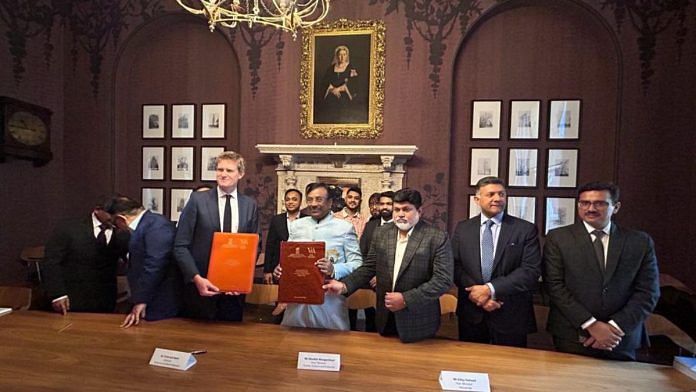Mumbai: Triumphant cries of ‘Jai Bhavani-Jai Shivaji’ erupted from the Maharashtra Mandal in London on Tuesday. Maratha warrior king Chhatrapati Shivaji’s deadly ‘tiger claw’ dagger, or ‘wagh nakh’, is coming back to Mumbai from the UK’s Victoria and Albert Museum, after all. Clad in traditional Marathi saris and turbans, community members celebrated to the beat of dhols.
“We are very, very happy because Shivaji Maharaj, for us, is no less than God. And I am getting those wagh nakh touched by Shivaji to Maharashtra,” Sudhir Mungantiwar, Maharashtra’s cultural minister, announced to the media.
But trouble is brewing back home in Maharashtra. Historians say there’s no conclusive proof that this wagh nakh belongs to Shivaji. And opposition members like Shiv Sena (UBT) leader Sanjay Raut are accusing the Bharatiya Janata Party of using Shivaji’s legacy to weaken the party further.
This comes after the state government signed a Memorandum of Understanding (MoU) with the museum to bring the famed weapon back to Maharashtra for three years.
“There’s no conclusive evidence [to prove this],” asserts Vaibhav Purandare, author of Shivaji: India’s Great Warrior King. According to Purandare and medieval weapons expert Indrajeet Sawant, there are multiple such tiger claws, and their references have come up many times. What is known for sure, however, is that Shivaji used a wagh nakh to kill Afzal Khan, commander of the opposing Bijapur army.
“We ought to be a little more diligent while making assertions. We owe it to history. What we can say at the most is that these tiger claws in the museum could be one of the likely candidates,” adds Purandare.
Even the Victoria and Albert Museum website states that “it’s not possible to verify” if these claws were indeed the ones used by Shivaji. The weapon belonged to East India Company officer James Grant Duff, who, in turn, got it from the Peshwa (prime minister) of the Marathas while residing in Satara. The case enclosing the ‘wagnuck’ was made after Duff returned to Scotland.
Also read:
History of the wagh nakh
Afzal Khan, a general who served the Adil Shah dynasty of Bijapur, was tasked with a military operation against Shivaji’s Maratha empire. According to the Victoria and Albert Museum, Shivaji and Khan arranged a truce and agreed to meet – alone and unarmed – in a tented enclosure during a protracted military engagement in 1659.
The catch, however, was that both carried concealed weapons. Shivaji wore chainmail under his clothes and metal skull protection under his turban. He also hid a metallic ‘tiger claw’ in his hand. The two men fought, and Shivaji “disembowelled his opponent”, states the website.
“This weapon was quite dangerous and was used to surprise the opponent. It was used in close combat without letting the opponent know,” says Sawant.
The fate of Shivaji’s tiger claws remains a mystery. The museum website goes on to state that the last Peshwa of the Marathas, Bajirao II, surrendered to the British in June 1818 after defeat in the Third Anglo-Maratha War. He was banished to Bithoor near Kanpur, and it is quite plausible that he surrendered this weapon to Duff.
According to historians, after Bajirao II’s defeat, the East India Company appointed Pratap Singh as Raja of Satara and Duff as his political advisor.
Sawant agrees that Duff got possession of a wagh nakh, but that’s where the trail goes cold. There is no historical proof that the claws in his possession were those used by Shivaji.
There are pictures to prove that Shivaji’s wagh nakh was in Satara till 1907, says Sawant. “So how are they claiming that those in Victoria and Albert Museum were original?”
Tracing the original wagh nakh is an uphill task, says Purandare. According to him, it is hard to document how and where it travelled after Shivaji’s death in 1680. Many more documents and artefacts were destroyed during the Mughal-Maratha wars, fought from Shivaji’s death to Aurangzeb’s in 1707.
Purandare stresses on the need to look further. “Maybe we need to go to Satara and check with the Chhatrapati family and see what possessions they have got. We can get the Archaeological Survey of India to find evidence and get details, but right now, the answer is we really don’t know where they [the claws] are – Satara or Kolhapur.”
What’s next?
The wagh nakh has not arrived in India yet. While Mungantiwar asked for it “immediately, within a month or two,” the museum told him that the process is long. “We will also try to keep them in our country on a permanent basis,” he added.
After it arrives on Indian soil, the wagh nakh will be on display in four of Maharashtra’s top museums – Shri Chhatrapati Shivaji Maharaj Museum in Satara, Central Museum in Nagpur, Lakshmi Vilas Palace in Kolhapur, and Chattrapati Shivaji Maharaj Vastu Sanghralaya in Mumbai (CSMVS).
Safety and security need to be taken care of first, says Sabyasachi Mukherjee, director general and secretary of CSMVS. “The only information that we have is one of the shows will be in Mumbai. And when it is, we will be involved. Nothing more has been decided.”
The wagh nakh, however, will be easier to manage than artefacts made from organic materials like paper or textile, adds Mukherjee.
“I am all in favour of getting the [wagh nakh] back, but what we need to do is due diligence, and we need to find out [what] is real and [what is] not real,” says Purandare. Calling the claws real without trying to ascertain if they are is not a good move, he adds. “It is an approach that I don’t follow as a historian, as our search is for the truth.”
(Edited by Zoya Bhatti)



